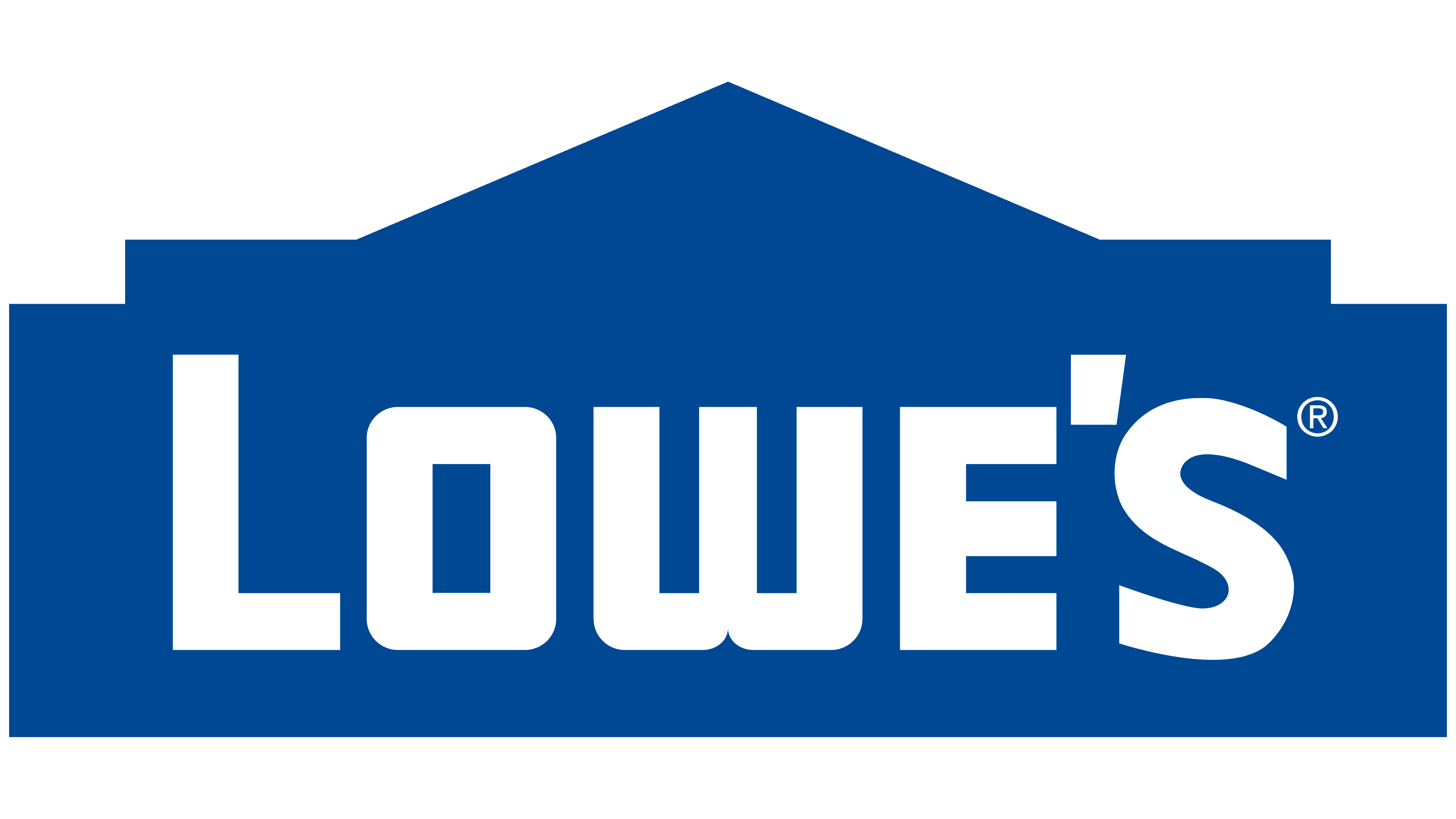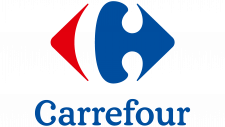Lowe’s Logo
Lowe’s, a leading home improvement retailer, offers a diverse range of products for construction, maintenance, and beautification projects. With its roots in the U.S., Lowe’s has expanded its footprint to Canada and Mexico, catering to both DIY enthusiasts and professional contractors. Beyond brick-and-mortar stores, its e-commerce platform witnesses significant traffic. The company is publicly traded on the NYSE under the ticker “LOW” and overseen by a board of directors. Today, it continually innovates to enhance customer experience, integrating technology with traditional retail to stay ahead in a competitive market.
Meaning and history
Lowe’s began its journey in 1921 when L. S. Lowe opened a hardware store in North Wilkesboro, North Carolina. Over time, under the stewardship of his son, Carl Buchan, the company expanded post-WWII by focusing on supplying construction needs, distinguishing itself from traditional hardware stores.
In the 1960s, Buchan transformed Lowe’s into a chain of retail home centers in the U.S., focusing on customer needs. This transition marked a pivotal growth phase. In 1961, Lowe’s went public, trading on the NYSE as “LOW.”
The 1980s and 1990s saw Lowe’s undertaking vast expansions, moving into larger standalone locations with wider inventory selections. The company also started targeting metropolitan markets, a significant shift from its previous rural and small-town focus.
In the new millennium, Lowe’s commenced its global expansion, entering the Canadian market in 2007 and later, Mexico. Throughout its growth, Lowe’s remained committed to innovation. Embracing the digital age, it revamped its online presence and integrated tech solutions for better customer engagement.
Though its leadership has transitioned over the decades, the company’s mission to help customers improve and beautify their living spaces has remained constant. Today, Lowe’s stands as one of the largest home improvement retailers globally, testament to its adaptability and commitment to customer satisfaction.
1921 – 1955
The logo showcased a straightforward, horizontal text layout. Every letter was capitalized, emphasizing the brand’s ambition to distinguish itself amid rivals, showcasing its diversity and vast product range. The characters, devoid of any decorative serifs, hinted at modernity and simplicity. This design choice was intentional, aiming to position the company as a forward-thinking entity in a competitive marketplace. The boldness of the typography hinted not only at the brand’s confidence but also its eagerness to be seen as a leading and reliable choice for consumers. The sheer simplicity of the design made it both memorable and a testament to the company’s clarity in its mission and vision.
1955 Januare – June
The emblem was purely informative, ensuring that customers could swiftly grasp the crucial details. Additionally, the aim was to imprint the brand in consumers’ minds for easy differentiation amidst competitors. Essential information was situated on a horizontal elongated form, using geometric characters spaced generously. The typography was straightforward – stark and entirely in upper case. The monochrome color scheme, using blacks and whites, added to the logo’s clarity and standout presence. This design strategy ensured the brand’s message was both clear and impactful, targeting instant recognition and trustworthiness in a bustling market landscape.
1955 June – November
Following numerous evolutions, the Lowe’s brand underwent a revolutionary logo change. This new emblem showcased a prominent title, encircled by a band featuring diverse taglines. The design team injected a fresh flair into the typography, ensuring each letter had its unique touch. Notably, the letter “E” was enhanced with slanting trims at its extremities. Similarly, the lower portion of “L” exhibited a diagonal notch. The characters were notably thick and bold, exuding confidence. This revised design aimed to resonate with the evolving audience, simultaneously paying homage to Lowe’s legacy, and establishing a firm visual identity in a competitive marketplace.
1955 – 1956
The audacity of the typography for the chain’s branding persisted, yet there was a reshuffle in the arrangement of the text. The creative team restructured the layout, positioning “Lowe’s” vertically, with each letter stacked above the other. Further, the brand name was accentuated with a broad underscore, which sported rounded terminations. This fresh approach was a nod to modern design while ensuring that the brand’s legacy and prominence remained undiminished, making a clear statement in the retail landscape and setting a distinctive tone for the store’s identity.
1956 – 1957
Following the redesign, Lowe’s emblem adopted a more pronounced presence: the brand’s name, amplified by fifty percent, dominated the entirety of the dark rectangular backdrop. The previously noted angular cuts at the extremities of the characters were omitted, rendering the typography sleek and streamlined. This evolution signified a shift towards a minimalist and contemporary aesthetic, highlighting the brand’s adaptability while maintaining its core identity. The designers embraced simplicity, focusing on clarity and recognizability, ensuring the logo’s effectiveness in various platforms and contexts. This strategic move underscored Lowe’s commitment to being both modern and accessible to its diverse clientele.
1957 – 1958
The singular alteration was observed in the apostrophe’s design. Its previous curve was straightened, and it was tilted, giving it the semblance of a slanted rectangle. This nuanced modification, although seemingly minor, added a fresh dimension to the overall look. The reimagined punctuation symbol offered a subtle touch of modernity, hinting at the brand’s evolving identity. Such meticulous attention to detail underscores the importance of even the tiniest elements in design, and how their transformation can convey a renewed sense of purpose or direction for a brand. It’s a testament to the fact that in the realm of design, sometimes the most understated changes can make a significant impact.
1958 – 1962
The emblem underwent a distinct transformation with the introduction of two elongated bands running horizontally across. Acting as defining boundaries, these bands were strategically positioned at the uppermost and lowermost edges of the brand name, “Lowe’s.” This new addition framed the word, giving it a more defined appearance. Furthermore, the designers subtly adjusted the lettering’s height, lending it a somewhat compressed feel. The overall effect of these changes was to create a more compact and cohesive visual identity. By making these adjustments, the designers highlighted the brand’s adaptability, all while retaining its core essence and familiarity to its audience.
1962 – 1965
The design team revamped the logo, infusing it with a three-dimensional aspect, transforming the previously flat letters into full-bodied structures. This dimensional treatment endowed each character with a tangible depth, making them stand out as distinct entities. With a striking black hue gracing the forefront and a contrasting white for the remaining facets, the lettering exuded a bold contrast. Notably, the “L” was magnified, towering over the rest, but all the letters retained their uppercase stature. Adjacently positioned to the left was a globe, acting as a testament to the store chain’s international presence. The continents on this sphere were delineated in muted grey tones, subtly underscoring the brand’s worldwide influence.
1965 – 1969
Contrary to its predecessor, the new emblem embraced more definitive shapes, predominantly featuring outlined characters. Every letter in the nameplate was demarcated with a pronounced black perimeter, creating a prominent boundary. In a creative twist, the design team softened the edges of the letters, lending them a gentle curvature. Interestingly, the “w” was revamped to mirror an inverted “m.” As for the apostrophe, it stood tall and erect, adopting a rectangular form, presenting a stark contrast to its earlier iterations. This design approach showcased the brand’s evolution, balancing both modernity and a nod to its past.
1969 – 1970
In this rendition of the emblem, the typography boasted prominently outlined characters. This bold framing reduced the visibility of the interior, lending the letters a more slender appearance. Interestingly, the once-rectangular apostrophe underwent a transformation, with its edges subtly trimmed, making it more square-like. This redesign, while seemingly minimal, signified a fresh take on the brand’s identity, highlighting their ability to evolve while maintaining recognizable elements from their heritage. The emphasis on bold outlines perhaps hinted at the brand’s resilience and determination in its industry, showcasing its continued commitment to innovation and excellence.
1970 – 1997
In this iteration, the creators elevated each letter to capitalize, yet distinctively retained the “L” to be more pronounced than its counterparts. They introduced a softened curvature to the external angles of the “O” and “W”, setting them apart from the sharply geometrical “E” and “L”, which remained starkly angular. The “S” took on a unique typeface and stood slightly apart, separated by a square symbol acting as an apostrophe. Moreover, there was a shift in the color palette. The fiery red was replaced by a deep shade of blue. This particular design became foundational for future logos and continues to represent the brand to this day, signifying its timeless appeal and recognition.
1997 – 2008
The leadership of the retail conglomerate opted for a logo revamp, aiming to encapsulate the essence of their operations, range, and core objectives. The creative team revamped the existing text’s hue and ensconced it within a blue geometric silhouette reminiscent of a dwelling. Beneath the brand’s designation, a subtitle was subtly integrated, reading “Home Enhancement Hub”. Surrounding the entirety of the symbol, intricate dual borders were crafted, employing shades of crimson and slate for distinction. This revamped design not only brought freshness but also provided a clearer insight into the company’s primary services and offerings.
2008 – Today
In an effort to streamline and harmonize the residential representation, the designers embarked on refining the existing logo rendition. They opted to eliminate the dual-toned crimson and slate border, along with the accompanying text. Subsequently, they subtly repositioned the brand’s name, shifting it downward for better visual alignment. Furthermore, the shade of blue underwent a transformation, becoming several nuances lighter to infuse the design with a more refreshing and contemporary vibe. This revision aimed to encapsulate a more minimalistic and modern approach, aligning the brand with current design trends and enhancing its appeal to the target audience.
























